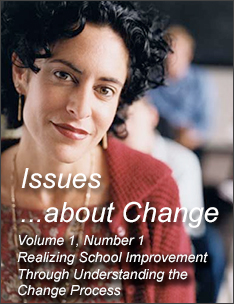Supportive Conditions
Several kinds of factors determine when, where, and how the staff can regularly come together as a unit to do the learning, decision making, problem solving, and creative work that characterize a professional learning community. In order for learning communities to function productively, the physical or structural conditions and the human qualities and capacities of the people involved must be optimal (Boyd, 1992; Louis & Kruse, 1995).
Physical conditions. Louis and Kruse identify the following physical factors that support learning communities: time to meet and talk, small school size and physical proximity of the staff to one another, interdependent teaching roles, well-developed communication structures, school autonomy, and teacher empowerment. An additional factor is the staff's input in selecting teachers and administrators for the school, and even encouraging staff who are not in tune with the program to find work elsewhere.
Boyd presents a similar list of physical factors that result in an environment conducive to school change and improvement: the availability of resources; schedules and structures that reduce isolation; policies that encourage greater autonomy, foster collaboration, enhance effective communication, and provide for staff development. Time is clearly a resource: "Time, or more properly lack of it, is one of the most difficult problems faced by schools and districts." (Watts & Castle, 1993, p. 306). Time is a significant issue for faculties who wish to work together collegially, and it has been cited as both a barrier (when it is not available) and a supportive factor (when it is available) by staffs engaging in school improvement.
People capacities. One of the first characteristics cited by Louis and Kruse (1995) of individuals in a productive learning community is a willingness to accept feedback and to work toward improvement. In addition, the following qualities are needed: respect and trust among colleagues at the school and district level, possession of an appropriate cognitive and skill base that enables effective teaching and learning, supportive leadership from administrators and others in key roles, and relatively intensive socialization processes.
Note the strong parallel with the people or human factors identified by Boyd (1992): positive teacher attitudes toward schooling, students, and change; students' heightened interest and engagement with learning (which could be construed as both an outcome and an input, it seems); norms of continuous critical inquiry and continuous improvement; a widely shared vision or sense of purpose; a norm of involvement in decision making; collegial relationships among teachers; positive, caring student-teacher-administrator relationships; a sense of community in the school; and two factors beyond the school staff - supportive community attitudes and parents and community members as partners and allies.
Boyd (1992) points out that the physical and people factors are highly interactive, many of them influencing the others. Boyd and Hord (1994) clustered the factors into four overarching functions that help build a context conducive to change and improvement: reducing staff isolation, increasing staff capacity, providing a caring and productive environment, and improving the quality of the school's programs for students.
Next Page: Shared Personal Practice

